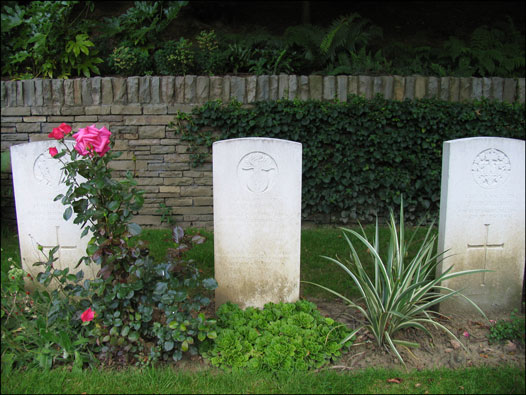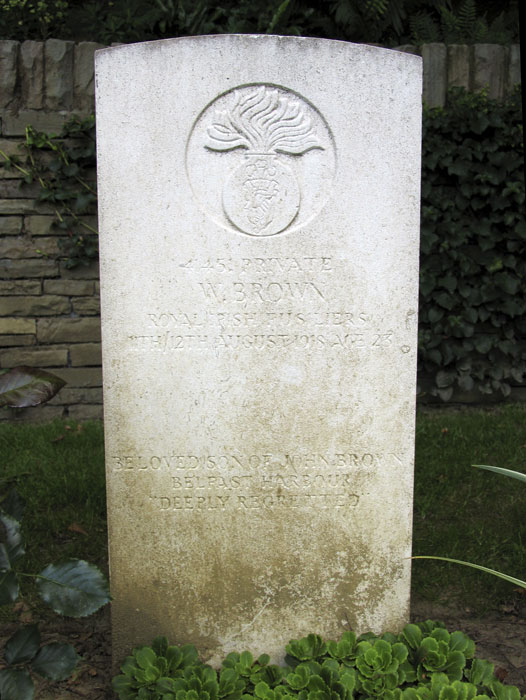![]() In memoriam
In memoriam ![]()
Private William Johnston Brown
William Johnston Brown was born on 13 February 1895 at 60 Solway Street, Belfast, the second of two children of time-keeper John Brown and his wife Isabella (formerly Mitchell, nee Johnston). William's older sister Martha had died just six weeks after she was born, and his mother died of typhoid fever before his second birthday. In 1902 his father was married again, to Sarah McMahon. The couple had two children in the next seven years.
By 1911 Brown was living with his father (chief timekeeper at Belfast Harbour), step-mother, half-brother and half-sister, at 51 Lichfield Avenue Belfast, and working in Belfast's Central Library as an assistant librarian.
Brown enlisted in the North Irish Horse at Antrim on 10 November 1915 (No.1839). He embarked for France on 11 August 1916, where he was posted to D Squadron, which was then part of the 1st North Irish Horse Regiment, joining it in the field at Humbercourt on 30 September.
In September 1917 the 2nd North Irish Horse Regiment was dismounted and most of its men, together with some surplus to the needs of the 1st Regiment, were transferred to the 9th (Service) Battalion, Royal Irish Fusiliers – which was renamed the 9th (North Irish Horse) Battalion. Brown was one of the men transferred for the 1st Regiment – on 20 September. He was issued a new regimental number, 41451, and posted to C Company.
Brown saw action with the 9th Battalion in the Battle of Cambrai in November and December 1917. On 12 December he reported to the field ambulance suffering from trench feet, but he was able to rejoin the battalion before the month was out. He was granted leave from 8 to 22 January 1918.
On 24 March 1918, during the retreat from St Quentin in the German spring offensive, Brown sustained gunshot wounds to his left thigh and right foot. He became separated from his battalion and was initially reported as missing. Brown was treated at the 46th Casualty Clearing Station and 62nd Field Ambulance, then the 72nd and 74th General Hospitals and 13th Convalescent Depot at Trouville in France.
After recovering from his wounds Brown rejoined his battalion in the field on the forward slope of Mont Noir on high ground known as Meulenhouck, on 19 July 1918. On the night of 11 August a large patrol attempted a raid on German-held Shoddy Farm. They got to within thirty yards of the farmhouse when attacked from behind by a German patrol. Grenades were thrown by the Germans and hand-to-hand fighting ensued. Eventually the raiders made it to safety, with some casualties. Brown was brought in, badly wounded, but he died soon after.
Brown was initially buried in the Wolfhoek British Cemetery, St Jans-Cappel, about 200 metres south-west of the hamlet of Wolfhoek (map reference 28.M.26.c.0.0), the location marked with a cross. In 1919 his body, and those of the others buried there, were exhumed and re-buried in the Mont Noir Military Cemetery, St Jans-Cappel, France, grave II.E.3. His gravestone inscription reads:
41451 PRIVATE
W. BROWN
ROYAL IRISH FUSILIERS
11TH/12TH AUGUST 1918 AGE 23
BELOVED SON OF JOHN BROWN
BELFAST HARBOUR
"DEEPLY REGRETTED"
Private Brown's father was notified of the reburial in the following letter:
I have to inform you that for various reasons it has been found necessary to exhume the body of your son No.41451 Private William Brown, 9th. Bn. Royal Irish Fusiliers and re-enter his remains in Mont Noir Military Cemetery 2½-miles N. of Bailleul 4¾ miles South of Poperinghe, (Report St. Jans Cappel 2 4/E). The new grave has been duly marked with a cross bearing all particulars and duly registered. The removal has been undertaken with every measure of care and reverence and the re-burial conducted by a Military Chaplain.

Images Copyright © Phillip Tardif with all rights reserved as set out in this Use of Material policy.

